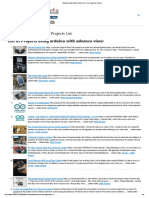Arduino Camera (OV7670) Tutorial - Microcontroller Tutorials
Uploaded by
Ivan BerlotArduino Camera (OV7670) Tutorial - Microcontroller Tutorials
Uploaded by
Ivan BerlotHOME TUTORIALS PROJECTS FEATURES REFERENCE ABOUT
Arduino Camera (OV7670) Tutorial
Ad
Search …
Electronics projects like movement and obstacle detection, drones, SEARCH
and robots require a camera for capturing images. I personally
recommend using a Raspberry Pi or BeagleBone Black for these kind Ad
of projects because the Arduino doesn’t have enough juice to handle
Magnetic encoder manufacturer the complexities of pictures and, more so, videos. However, if the
project doesn’t require a high resolution image then the OV7670
Open
camera module might be for you. This arduino camera tutorial
features such camera and how you can use it to capture VGA-sized
pictures.
Leading encoder manufacturer
RECENT POSTS Cyber Ofertas MSC - Tu momento es ahora
Cruceros Bs As Brasil - Salidas 14 y 23 de Enero 69.990 Pesos -
Hasta 6 cuotas s/interés promocionesmsc.com.ar Open
Featured: Seeeduino Nano
The Seeeduino Nano is I managed to buy a OV7670 camera module that looks like this:
Seeedstudio’s version of the
new Arduino …
Related posts:
Solid State Relay Tutorial | WiFi Switch
Relays in electronics are
useful for controlling a high-
power load …
Detect Objects Arduino
with Camera and NRF24L01
Automobile Wire Harness - The Ultimate Guide
Sponsored Post by Cloom
Cloom, a reliable wire
harness, and …
Custom PCB- To Getting The Best Results Uploading Camera HC-SR04 and
PCB is an indispensable unit Images from Arduino
in the electronic products
that …
As you can see, the module has 18 output pins with the following
functions:
Optimal Circuit Boards Information Guide
Guest Post from OurPCB Do
you know what the PCB …
RECOMMENDED PRODUCT:
ESP32 WiFi Camera
Some modules contain 16 pins; these lack the RESET and PWON
pins. Since I own the 18-pin OV7670 module, the rest of the tutorial
will be based on such module.
If you noticed, the OV7670 camera module has a serial data and
clock pin. This means that the Arduino can communicate with the
module using I2C. Also, the module operates on 3.3 V so if we are to
send data to the OV7670 from the Arduino, we must use a voltage
divider to bring the level down.
Here is a common wiring diagram used to build an Arduino camera
using the OV7670 camera module:
Ad
Encoder products company
Open
Note that there is no e cient way for the Arduino to display the
captured image. What it only does is command the module to take a
picture, acquire the image and then send it to a computer via the
Arduino’s USB port. Thus, you need to have another application that
will display the image from the USB port to your desktop computer.
Here is a code to be used to capture an image using the Arduino and
OV7670 camera module:
1 #define F_CPU 16000000UL
2 #include <stdint.h>
3 #include <avr/io.h>
4 #include <avr/interrupt.h>
5 #include <util/twi.h>
6 #include <util/delay.h>
7 #include <avr/pgmspace.h>
8 #include "ov7670.h"
9 /* Configuration: this lets you easily change between different reso
10 * You must only uncomment one
11 * no more no less*/
12 #define useVga
13 //#define useQvga
14 //#define useQqvga
15
16 static inline void serialWrB(uint8_t dat){
17 while(!( UCSR0A & (1<<UDRE0)));//wait for byte to transmit
18 UDR0=dat;
19 while(!( UCSR0A & (1<<UDRE0)));//wait for byte to transmit
20 }
21 static void StringPgm(const char * str){
22 do{
23 serialWrB(pgm_read_byte_near(str));
24 }while(pgm_read_byte_near(++str));
25 }
26 static void captureImg(uint16_t wg,uint16_t hg){
27 uint16_t lg2;
28 #ifdef useQvga
29 uint8_t buf[640];
30 #elif defined(useQqvga)
31 uint8_t buf[320];
32 #endif
33 StringPgm(PSTR("RDY"));
34 //Wait for vsync it is on pin 3 (counting from 0) portD
35 while(!(PIND&8));//wait for high
36 while((PIND&8));//wait for low
37 #ifdef useVga
38 while(hg--){
39 lg2=wg;
40 while(lg2--){
41 while((PIND&4));//wait for low
42 UDR0=(PINC&15)|(PIND&240);
43 while(!(PIND&4));//wait for high
44 }
45 }
46 #elif defined(useQvga)
47 /*We send half of the line while reading then half later */
48 while(hg--){
49 uint8_t*b=buf,*b2=buf;
50 lg2=wg/2;
51 while(lg2--){
52 while((PIND&4));//wait for low
53 *b++=(PINC&15)|(PIND&240);
54 while(!(PIND&4));//wait for high
55 while((PIND&4));//wait for low
56 *b++=(PINC&15)|(PIND&240);
57 UDR0=*b2++;
58 while(!(PIND&4));//wait for high
59 }
60 /* Finish sending the remainder during blanking */
61 lg2=wg/2;
62 while(!( UCSR0A & (1<<UDRE0)));//wait for byte to tr
63 while(lg2--){
64 UDR0=*b2++;
65 while(!( UCSR0A & (1<<UDRE0)));//wait for by
66 }
67 }
68 #else
69 /* This code is very similar to qvga sending code except we
70 while(hg--){
71 uint8_t*b=buf,*b2=buf;
72 lg2=wg/5;
73 while(lg2--){
74 while((PIND&4));//wait for low
75 *b++=(PINC&15)|(PIND&240);
76 while(!(PIND&4));//wait for high
77 while((PIND&4));//wait for low
78 *b++=(PINC&15)|(PIND&240);
79 while(!(PIND&4));//wait for high
80 while((PIND&4));//wait for low
81 *b++=(PINC&15)|(PIND&240);
82 while(!(PIND&4));//wait for high
83 while((PIND&4));//wait for low
84 *b++=(PINC&15)|(PIND&240);
85 while(!(PIND&4));//wait for high
86 while((PIND&4));//wait for low
87 *b++=(PINC&15)|(PIND&240);
88 UDR0=*b2++;
89 while(!(PIND&4));//wait for high
90 }
91 /* Finish sending the remainder during blanking */
92 lg2=320-(wg/5);
93 while(!( UCSR0A & (1<<UDRE0)));//wait for byte to tr
94 while(lg2--){
95 UDR0=*b2++;
96 while(!( UCSR0A & (1<<UDRE0)));//wait for by
97 }
98 }
99 #endif
100 }
101 int main(void){
102 cli();//disable interrupts
103 /* Setup the 8mhz PWM clock
104 * This will be on pin 11*/
105 DDRB|=(1<<3);//pin 11
106 ASSR &= ~(_BV(EXCLK) | _BV(AS2));
107 TCCR2A=(1<<COM2A0)|(1<<WGM21)|(1<<WGM20);
108 TCCR2B=(1<<WGM22)|(1<<CS20);
109 OCR2A=0;//(F_CPU)/(2*(X+1))
110 DDRC&=~15;//low d0-d3 camera
111 DDRD&=~252;//d7-d4 and interrupt pins
112 _delay_ms(3000);
113 //set up twi for 100khz
114 TWSR&=~3;//disable prescaler for TWI
115 TWBR=72;//set to 100khz
116 //enable serial
117 UBRR0H=0;
118 UBRR0L=1;//0 = 2M baud rate. 1 = 1M baud. 3 = 0.5M. 7 = 250k
119 UCSR0A|=2;//double speed aysnc
120 UCSR0B = (1<<RXEN0)|(1<<TXEN0);//Enable receiver and transmi
121 UCSR0C=6;//async 1 stop bit 8bit char no parity bits
122 camInit();
123 #ifdef useVga
124 setRes(VGA);
125 setColorSpace(BAYER_RGB);
126 wrReg(0x11,25);
127 #elif defined(useQvga)
128 setRes(QVGA);
129 setColorSpace(YUV422);
130 wrReg(0x11,12);
131 #else
132 setRes(QQVGA);
133 setColorSpace(YUV422);
134 wrReg(0x11,3);
135 #endif
136 /* If you are not sure what value to use here for the divide
137 * Values I have found to work raw vga 25 qqvga yuv422 12 qv
138 * run the commented out test below and pick the smallest va
139 while (1){
140 /* captureImg operates in bytes not pixels in some c
141 * So for the width (if you were reading 640x480) yo
142 /*uint8_t x=63;//Uncomment this block to test divide
143 do{
144 wrReg(0x11,x);
145 _delay_ms(1000);*/
146 #ifdef useVga
147 captureImg(640,480);
148 #elif defined(useQvga)
149 captureImg(320*2,240);
150 #else
151 captureImg(160*2,120);
152 #endif
153 //}while(--x);//Uncomment this line to test divider
154 }
155 }
Note that this code requires the ov7670 library which was originally
done by ComputerNerd. Download the library on this repository.
Next, we need a desktop application that will read the image data
from the Arduino’s USB port and display it on screen. Download this
C/C++ package and run it using G++ for Linux or DevC++ for
Windows. Unfortunately, C/C++ programming on desktop computers
is beyond the scope of this tutorial so I can’t help you with this
further.
Hopefully I’ve helped you in setting up the OV7670 camera module
with the Arduino UNO. However, I would still recommend you use
more advanced boards like Raspberry Pi or BeagleBone Black to
handle images as the Arduino UNO is simply not powerful enough.
Check out my tutorial on using a web camera with the Raspberry Pi
and create cool projects!
4 thoughts on “Arduino Camera (OV7670) Tutorial”
Partha
June 7, 2019 at 11:27 am
Thank you very much for sharing your hard work. It helps people like me immensely
Reply
Christophe Trouillefou
June 20, 2019 at 11:31 pm
Hello,
I'm trying desparately to make the camera OV7670 that contains a FIFO work with an
arduino uno and record pictures on an SD card. If you have a simple code to make this
dream become true (or even a good link to help).
Everywhere on the web I only nd info about OV7670 (without Fifo) + Uno.
Thx
Reply
lady saori
July 12, 2019 at 11:56 am
very usefull .thanks for this hard work. I am also working on this project and i really
want to know how to print images and treat them to prohibit that a car start.thank
i am waiting
Reply
Jeevan
October 11, 2019 at 9:15 pm
i'm working with the OV7670 module on an altera FPGA Board and i'm encountering
some problems wich i cannot solve.
The YCbCr422 encoding is the default format used by the camera module right?
If so what are the exact data position/order that the camera is using on it's D0-7 pin?
When you explain how the data is stored for the YCbCr format you make a block
scheme.
What those blocks represents? Are they Bytes? If so one block would be the
information present on D0-7 pins at a certain pclk edge?
Reply
Leave a Reply
Your email address will not be published. Required elds are marked *
Comment
Name *
Email *
Website
POST COMMENT
This site uses Akismet to reduce spam. Learn how your comment data is processed.
CATEGORIES TAGS RECENT COMMENTS
Arduino Projects (10) accelerometer ajax apache asm breakout board camera ccp control Devendra on Intro to NodeMCU and
Arduino Tutorial (58) Arduino IDE
system esp8266 gprs gps gsm hall e ect hc-sr04
Teach Me Microcontrollers! BeagleBone Tutorial (16) Adri on Arduino GPRS Tutorial
ESP8266 Projects (3) hd44780 lcd humidity i2c IMU Internet interrupt iot Mahmoud on Beaglebone Black
Arduino, PIC, Raspberry Pi, STM32, ESP8266 Tutorial (15) javascript LED linux gyro motion sensor motor mpu6050 mqtt Serial Connection to Arduino
Beaglebone Tutorials Features (7) oled pdf pic16f877a pinout pwm python schematic sensor maynerd on Using an Arduino
General (4) serial serial-to-usb sim800 spi temperature ttl-to-usb ubuntu Turbidity Sensor
All Rights Reserved 2019 Guest Post (7) continuous adc web server xc8
Meg on LPG Sensor with MQ-6 and
PIC Projects (5) Arduino
PIC Tutorial (20)
Product Reviews (3)
Raspberry Pi Projects (1)
Raspberry Pi Tutorial (14)
Reference (8)
STM32 Tutorial (6)
Developed by Dessign
You might also like
- Workshop Manual: Group 20 Technical Data E100% (3)Workshop Manual: Group 20 Technical Data E56 pages
- Advanced View Arduino Projects List - Use Arduino For ProjectsNo ratings yetAdvanced View Arduino Projects List - Use Arduino For Projects59 pages
- Advanced View Arduino Projects List - Use Arduino For Projects-2No ratings yetAdvanced View Arduino Projects List - Use Arduino For Projects-259 pages
- Advanced View Arduino Projects List - Use Arduino For Projects 5No ratings yetAdvanced View Arduino Projects List - Use Arduino For Projects 556 pages
- Advanced View Arduino Projects List - Use Arduino For Projects 4No ratings yetAdvanced View Arduino Projects List - Use Arduino For Projects 465 pages
- Advanced View Arduino Projects List - Use Arduino For Projects 3No ratings yetAdvanced View Arduino Projects List - Use Arduino For Projects 363 pages
- List of Projects Using Arduino With Advance ViewNo ratings yetList of Projects Using Arduino With Advance View59 pages
- Advanced View Arduino Projects List - Use Arduino For Projects-3No ratings yetAdvanced View Arduino Projects List - Use Arduino For Projects-357 pages
- Esp8266 Arduino Projects List in PDF Offline Downloadable 1No ratings yetEsp8266 Arduino Projects List in PDF Offline Downloadable 114 pages
- Atmel 42439 From Maker To Manufacture Bridging The Gap From Arduino To AVR TrainingManualNo ratings yetAtmel 42439 From Maker To Manufacture Bridging The Gap From Arduino To AVR TrainingManual48 pages
- Advanced View Arduino Projects List - Use Arduino For ProjectsNo ratings yetAdvanced View Arduino Projects List - Use Arduino For Projects59 pages
- How To Use OV7670 Camera Module With ArduinoNo ratings yetHow To Use OV7670 Camera Module With Arduino6 pages
- Advanced View Arduino Projects List - Use Arduino For Projects100% (1)Advanced View Arduino Projects List - Use Arduino For Projects95 pages
- API RP 545 Lightning Protection For Above Ground Storage TanksNo ratings yetAPI RP 545 Lightning Protection For Above Ground Storage Tanks11 pages
- List of Projects Using Arduino With Advance ViewNo ratings yetList of Projects Using Arduino With Advance View64 pages
- How To Make Arduino On Breadboard - Step by Step Instructions - Homemade Circuit Projects PDFNo ratings yetHow To Make Arduino On Breadboard - Step by Step Instructions - Homemade Circuit Projects PDF12 pages
- Advanced View Arduino Projects List - Use Arduino For Projects (5)No ratings yetAdvanced View Arduino Projects List - Use Arduino For Projects (5)49 pages
- Advanced View Arduino Projects List Part 3 - Use Arduino For ProjectsNo ratings yetAdvanced View Arduino Projects List Part 3 - Use Arduino For Projects97 pages
- Advanced View Arduino Projects List - Use Arduino For Projects-5No ratings yetAdvanced View Arduino Projects List - Use Arduino For Projects-567 pages
- Advanced View Arduino Projects List - Use Arduino For Projects-2No ratings yetAdvanced View Arduino Projects List - Use Arduino For Projects-270 pages
- Advanced View Arduino Projects List - Use Arduino For Projects 1No ratings yetAdvanced View Arduino Projects List - Use Arduino For Projects 159 pages
- Advanced View Arduino Projects List - Use Arduino For ProjectsNo ratings yetAdvanced View Arduino Projects List - Use Arduino For Projects71 pages
- Advanced View Arduino Projects List - Use Arduino For Projects (6)No ratings yetAdvanced View Arduino Projects List - Use Arduino For Projects (6)11 pages
- Advanced View Arduino Projects List - Use Arduino For ProjectsNo ratings yetAdvanced View Arduino Projects List - Use Arduino For Projects107 pages
- Glass LED Tube Lights: Arduino & Visual Basic 6 Light ControllerNo ratings yetGlass LED Tube Lights: Arduino & Visual Basic 6 Light Controller6 pages
- Advanced View Arduino Projects List - Use Arduino For Projects-3No ratings yetAdvanced View Arduino Projects List - Use Arduino For Projects-358 pages
- Advanced View Arduino Projects List - Use Arduino For ProjectsNo ratings yetAdvanced View Arduino Projects List - Use Arduino For Projects50 pages
- Advanced View Arduino Projects List - Use Arduino For ProjectsNo ratings yetAdvanced View Arduino Projects List - Use Arduino For Projects97 pages
- User Guide For Arduino Electronic Bricks Advanced Kit v2.0r4100% (1)User Guide For Arduino Electronic Bricks Advanced Kit v2.0r431 pages
- Programming ESP8266 ESP 12E NodeMCU Using ArduinoNo ratings yetProgramming ESP8266 ESP 12E NodeMCU Using Arduino7 pages
- Advanced View Arduino Projects List - Use Arduino For Projects-3No ratings yetAdvanced View Arduino Projects List - Use Arduino For Projects-358 pages
- How To Make Arduino Ohm Meter - Kiyani SolutionsNo ratings yetHow To Make Arduino Ohm Meter - Kiyani Solutions3 pages
- Advanced View Arduino Projects List - Use Arduino For ProjectsNo ratings yetAdvanced View Arduino Projects List - Use Arduino For Projects47 pages
- Advanced View Arduino Projects List Part 3 - Use Arduino For ProjectsNo ratings yetAdvanced View Arduino Projects List Part 3 - Use Arduino For Projects106 pages
- List of Projects Using Arduino With Advance ViewNo ratings yetList of Projects Using Arduino With Advance View2 pages
- Advanced View Arduino Projects List - Use Arduino For Projects-4No ratings yetAdvanced View Arduino Projects List - Use Arduino For Projects-455 pages
- Step by Step Guide To The Arduino LeonardoNo ratings yetStep by Step Guide To The Arduino Leonardo4 pages
- Advanced View Arduino Projects List - Use Arduino For Projects-3No ratings yetAdvanced View Arduino Projects List - Use Arduino For Projects-358 pages
- Touche For Arduino Advanced Touch SensingNo ratings yetTouche For Arduino Advanced Touch Sensing6 pages
- Advanced View Arduino Projects List - Use Arduino For Projects100% (1)Advanced View Arduino Projects List - Use Arduino For Projects96 pages
- Advanced View Arduino Projects List - Use Arduino For Projects-4No ratings yetAdvanced View Arduino Projects List - Use Arduino For Projects-462 pages
- Arduino For Beginners: How to get the most of out of your Arduino, including Arduino basics, Arduino tips and tricks, Arduino projects and more!From EverandArduino For Beginners: How to get the most of out of your Arduino, including Arduino basics, Arduino tips and tricks, Arduino projects and more!No ratings yet
- Arduino: The Ultimate Guide to Arduino for Beginners Including Arduino Basics, Tips & Tricks, Projects, and More!From EverandArduino: The Ultimate Guide to Arduino for Beginners Including Arduino Basics, Tips & Tricks, Projects, and More!No ratings yet
- Electronics: Automatic Voltage RegulatorNo ratings yetElectronics: Automatic Voltage Regulator7 pages
- Experiment FT2: Measurement of Inductance and Mutual InductanceNo ratings yetExperiment FT2: Measurement of Inductance and Mutual Inductance8 pages
- WNCC-Kiln Overhaul Shutdown Plan 01-07-2020, Rev#00 (Update To 19-7-2020)No ratings yetWNCC-Kiln Overhaul Shutdown Plan 01-07-2020, Rev#00 (Update To 19-7-2020)15 pages
- Speed Torque Gear Ratios Motor Vehicles Internal Combustion Engine Rotational Speed Torque100% (1)Speed Torque Gear Ratios Motor Vehicles Internal Combustion Engine Rotational Speed Torque45 pages
- 800ma Low Dropout Positive Voltage RegulatorNo ratings yet800ma Low Dropout Positive Voltage Regulator6 pages
- Steam Valves With Rotary Actuators: Technical DatabookNo ratings yetSteam Valves With Rotary Actuators: Technical Databook12 pages
- Short-Circuit Fault Current Limiters: I - Limiter and FC-ProtectorNo ratings yetShort-Circuit Fault Current Limiters: I - Limiter and FC-Protector19 pages
- Coinco Global 800 Series Operation and Service ManualNo ratings yetCoinco Global 800 Series Operation and Service Manual31 pages
- AMAN TEX LTD GH-RE-23-134-30.05.2023 FinalNo ratings yetAMAN TEX LTD GH-RE-23-134-30.05.2023 Final8 pages
- CNS72919 SJK (T) Convent Seremban (Kompleks Wawasan)No ratings yetCNS72919 SJK (T) Convent Seremban (Kompleks Wawasan)7 pages
- Asus RT-AX3000 Internet Router Quick Start GuideNo ratings yetAsus RT-AX3000 Internet Router Quick Start Guide72 pages

























































































